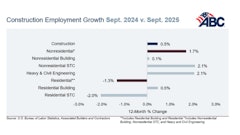
Technology is coming at the construction industry at a furious pace, leaving many (including me) scratching their heads as to what it means to contractors and their business going forward. One of the latest to hit the pavement is “blockchain” — which sounds cryptic, but fortunately, is not quite as confusing as it may first appear.
Originally developed as the framework for cryptocurrency (another enigma of the tech and financial worlds), blockchain is a lot like a digital bank ledger or checkbook. It digitally records transactions of credits and debits, their dates, transaction numbers and the parties involved, and gives users access to the data at varying levels. The recorded data makes up the “blocks” and the “chains” represent the activity that occurs in between (e.g., changes made and who made them).
So, how does blockchain apply to construction? According to Matthew Ramage, Trimble’s business area director for LEM (Labor, Equipment and Materials), it can help by removing most of the intermediaries involved in processing contracts and payments, as well as by streamlining project delivery and payment.
Consider all of the components that go into a larger project and all the information and individuals involved. Blockchain might be used to track materials and activities between the company and its vendors, transactions between the project owners, contractors and subs, etc., providing more transparency and reducing the potential for human error.
Blockchain uses what are termed “smart contracts.” Smart contracts secure, enforce and execute the settlement of recorded agreements between parties, and eliminate the need to chase down payments. Smart contracts may also be able to interface with BIM software, enabling better coordination with any stakeholders who have access to the model. As Ramage explains:
- The project schedule becomes hundreds of smart contracts in a common environment visible to all stakeholders.
- Each smart contract has a value. Completion and verification of a contract triggers an automatic payment.
- The project receives its next “block” of information, which updates the BIM model with the completed work and project spend.
Of course, as with any new technology, there are potential downside risks. While blockchain can cut down on errors or inconsistencies in digital documents (e.g., contracts or blueprints), any errors or typos in the original files could produce a ripple effect that may not be caught until the later project stages. And while designed to be highly secure, there is the ever-present risk of hackers accessing or interfering with digitally stored information.
There is clearly much yet to be learned about both the potential and the challenges associated with blockchain in construction. To start down this path, I recommend the article "Blockchain Transactions Poised to Revolutionize the Construction Industry".
Related Content:
Report: Blockchain Increases Cybersecurity Risks for Businesses, Government




















